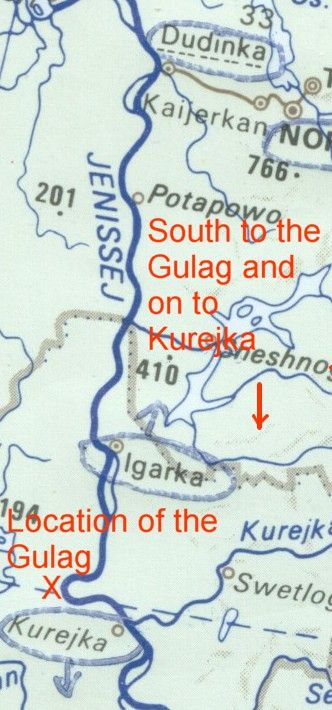The Yenisey River 2-Week Cruise

From 1 August to 8 August 1993
Green Forests, Beautiful Rivers, Stalin's Gulag Ruins,
Million Population Cities -- Siberia Had Them All
1400: We departed Dudinka, and headed upstream toward Krasnoyarsk,
1998 kilometers south.

Just a partial view of the huge harbor area around Dudinka, as we leave
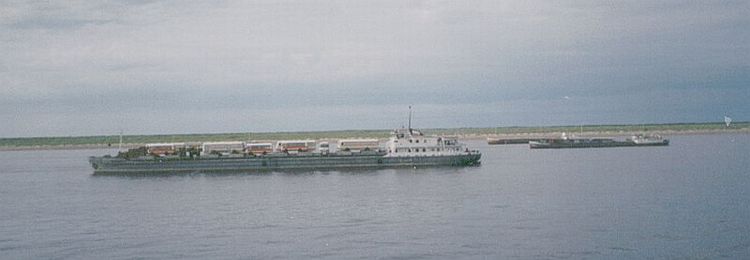
Typical of the many barges along the river
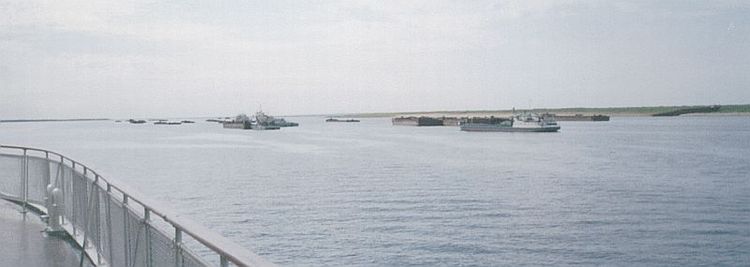
And traffic can get rather crowded also
After lunch, the tour guide gave a briefing about the gulag that we would
be visiting Monday. First, he said it was about 8 kilometers in and 8 kilometers
out. We would have to walk through marshes, mosquitos, flies, and possibly small
ground animals. It had been raining, so we had to expect slush, mud, and creeks
to fjord. There were no paved roads into the gulag. This gulag was for Stalin's
political enemies. Its purpose was to build a railroad. This railroad was jokingly
called the train to nowhere.
We found out later that the life expectancy here was about 3 months after arrival.
Between the long hours of work, starvation diet, long marches to and from the
gulag to the work area, and the mosquitoes, even the guards had short lives.
The gulag was closed after Stalin's death.
Then the lecturer stated what the Russians believe about the end of World War
II. When he mentioned that the Russians 'freed' Poland from the Germans, the
Polish passengers got upset and started yelling.
One of the buildings in this gulag was a theater that the prisoners built. The
prisoners could read their own poetry and this lecturer suggested that the prisoners
had a good time. On hearing this, the Polish audience got really upset and yelled
at him. For, it was general knowledge that many Poles were also sent to this
and other gulags, where they perished.
2100: The crew presented a Russian folk singing and dancing
jam session.

Monday, 3 August-0930-1450: Danuta and I, along with many others,
began the journey into the thick forests to view the remains of the gulag. It
was located about 8 kilometers inland west of the Yenisey River, on the north
side of the Jermakowo River junction. This location was just about on the Arctic
Circle. The first hundred yards were across the pebble beach of the Yenisey.
Then we turned uphill on a slippery, muddy path leading to a high plateau. For
the first two kilometers there was a plowed path, where tractors could travel.
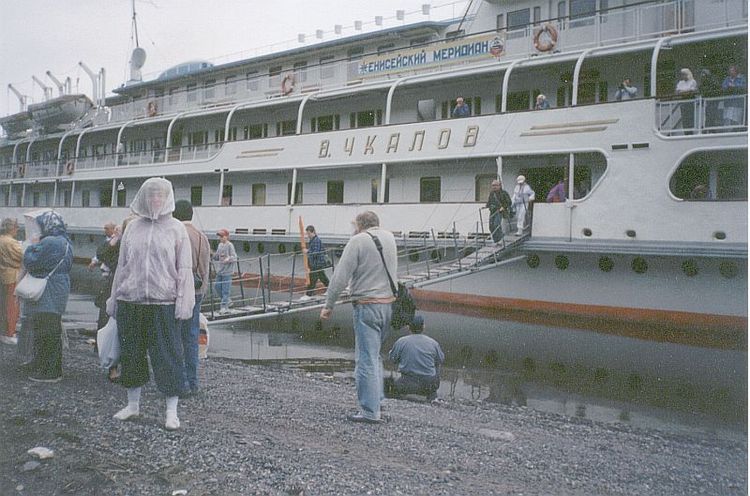
Danuta leaves the ship in full uniform. Nets and full protection against the mosquitoes
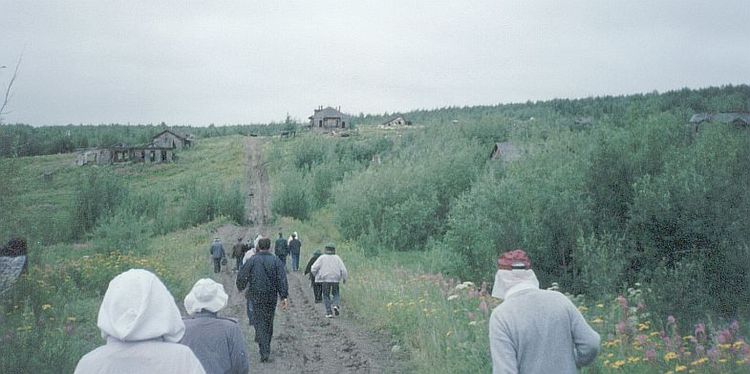
The pathway started out rather easy
We passed several deserted wooden homes that overlooked the confluence of the
rivers. After going down a ravine and back up the other side, we approached
a small community of homes. One had signs of current occupancy. There was a
sign suggesting that the person was the equivalent of a 'forest ranger'.
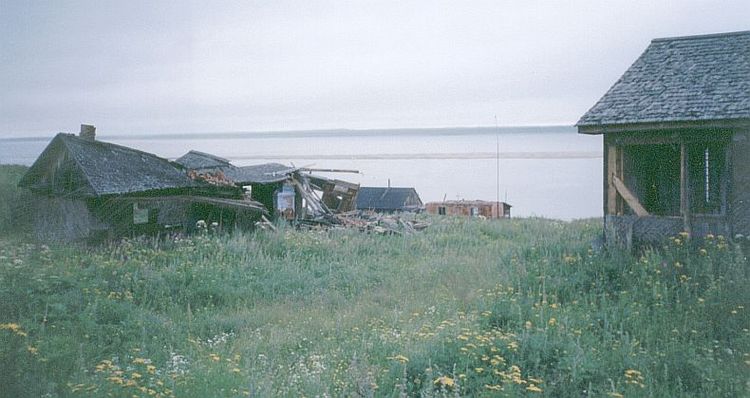
Small community of homes
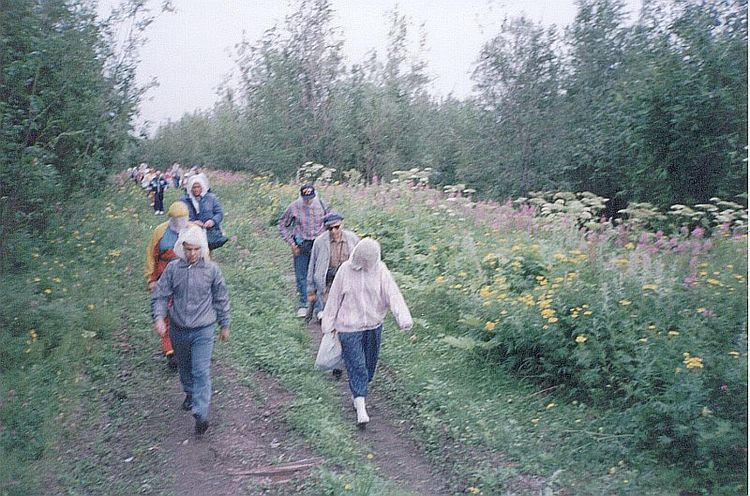
Continuing, most are still in bunches on the smooth walking areas
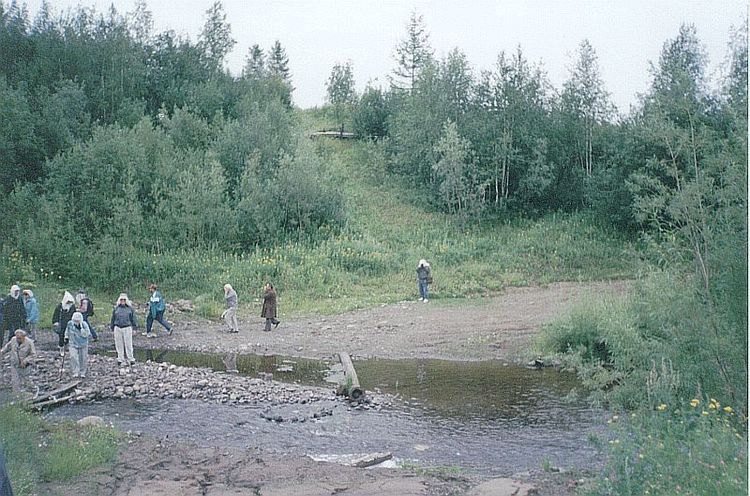
The beginning of the more limited walking area
At the 3-kilometer point, we came across on old steam engine sitting upright
on the ground. It was rusting away, and obviously had not been in operation
for many years. At this point, the guide suggested that those who were neither
daring nor capable of going on, should stay here until we returned. Danuta and
I decided to continue.
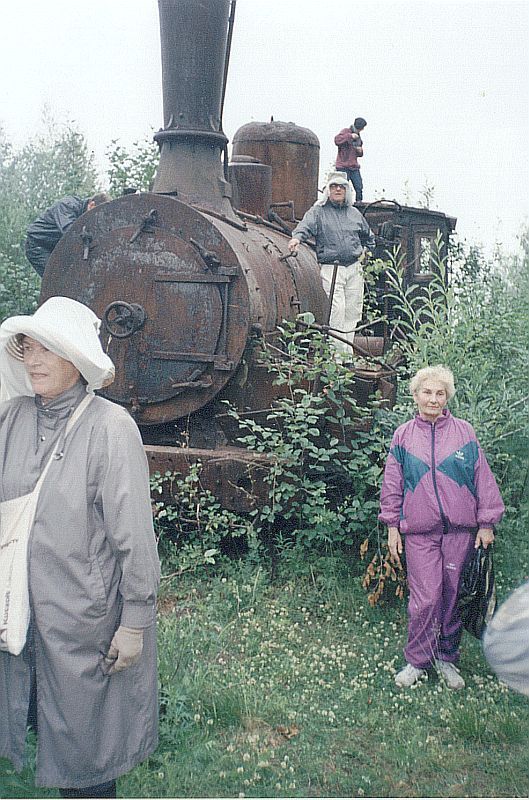
Lester standing on the old steam engine just rusting away. No evidence of rails are around here
The first three kilometers were hard walking. The next five kilometers were
even worse. The tractor width path, narrowed to just a single trail in places.
At least ten major puddles and flooded streams had to be carefully bypassed
by making a new trail through the undergrowth of the forest. Movement was slow.
At the 5-kilometer point we came across the remains of a large series of Quonset
hut type metal buildings. The guide told us that at this location the Soviets
had conducted many underground nuclear tests. I mean, wow, what were we doing
here? Everyone was going onto the depression which had the remains of a tower.
There was a sign in Russian (probably warning us to keep away), where they had
their photos taken. Me, too. I stood on the top of the pile, holding onto the
sign post, while Danuta took my picture.
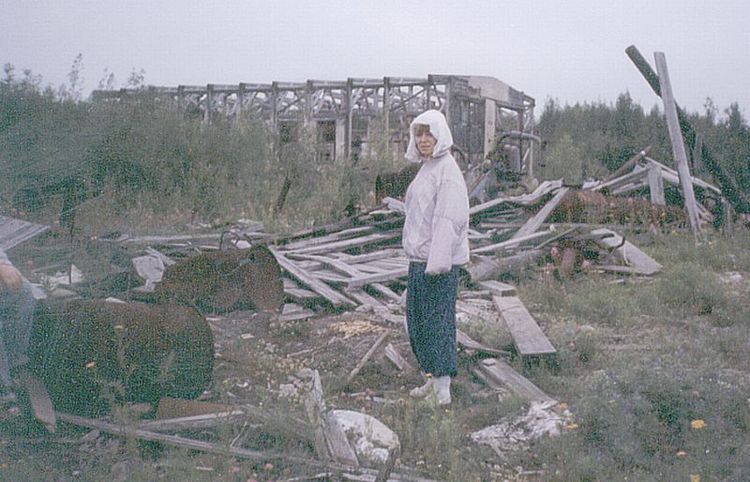
Part of the larger area of quonset type buildings used during the Soviet Atomic tests
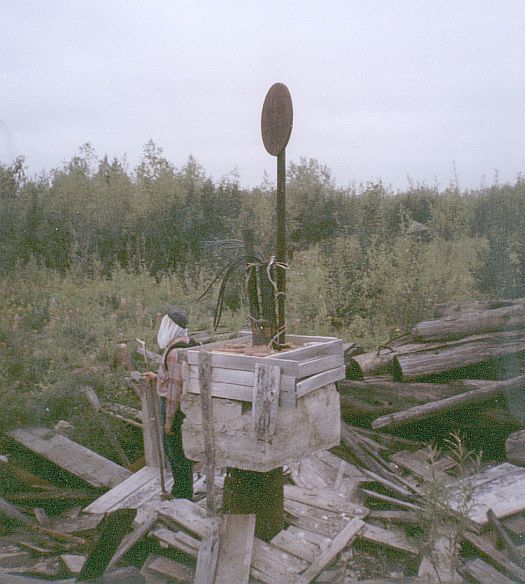
This is the spot where an underground bomb test took place back in the 1950's
After navigating the swampy like marshes and mud, we finally came across a large
concrete building. This was the main headquarters and housing for the guards.
We continued until we saw many smaller wooden (log cabin) structures lined up
in an orderly fashion. These were the homes for the prisoners. There were no
signs of bars on the windows. But, then if anyone tried to escape, where would
he go? I went inside three of the barrack like dormitories, and took some pictures
of the bunk beds.
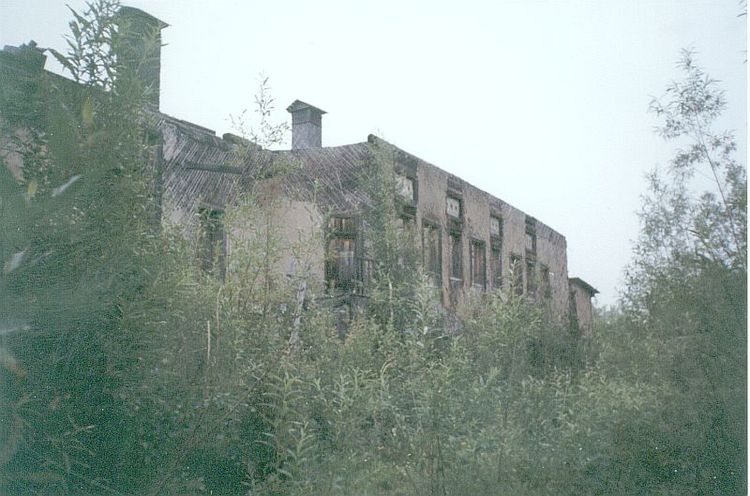
Administration and housing of guards building for the Gulag
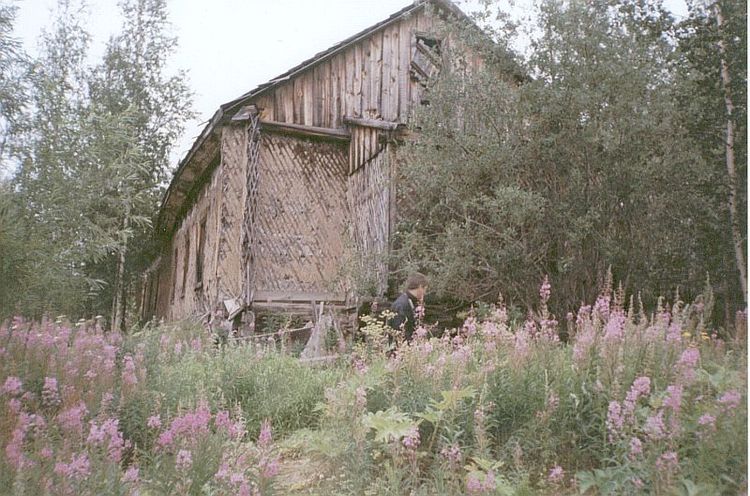
One of the prisoner buildings still standing. Pretty well covered by shrubbery
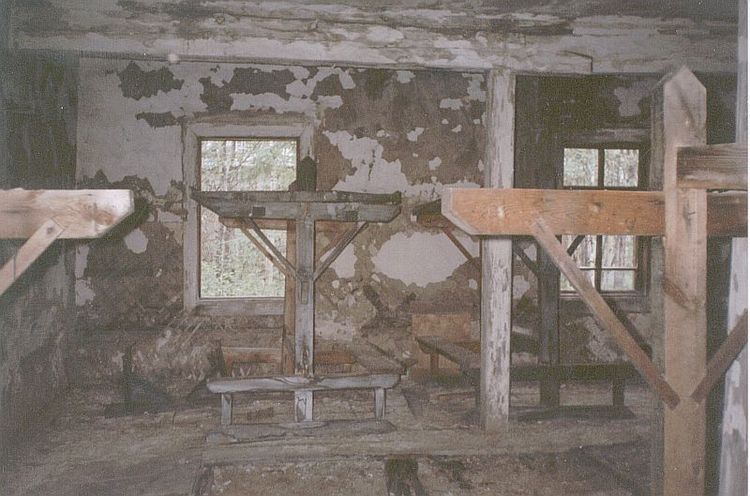
Inside view of frames used for bunk beds
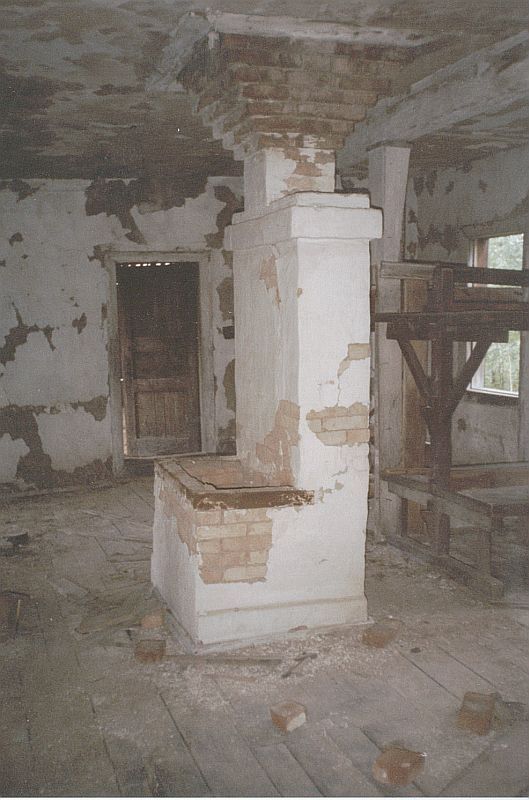
The wood burning heating unit inside the prisoner's barracks
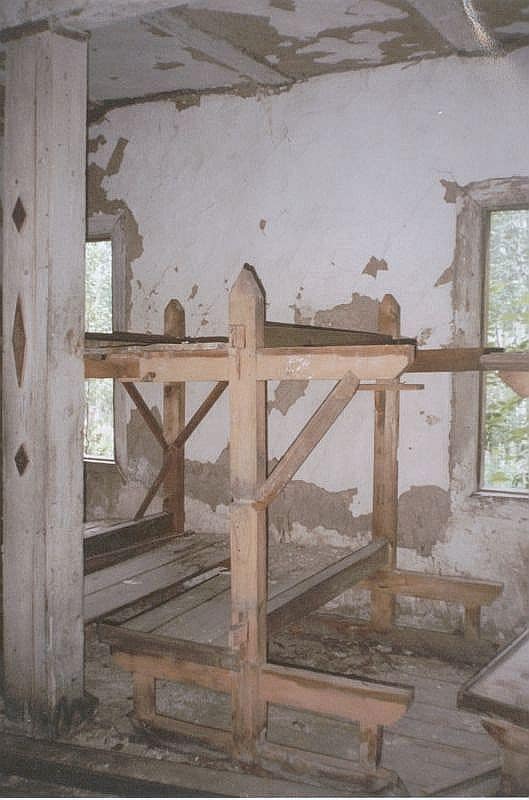
Another view of the bunk frames
The whole area was completely covered with shrubbery and trees that obviously
had grown over the years. As we walked along the rear perimeter, we came upon
a still standing watch tower. Walking again back to the start, we came upon
the prison of the gulag. There were solid doors with small windows and holes
to pass food. The small high windows looking outside were barred, but had no
glass. There was a wood burner heater in the outer chamber, probably to keep
the guards warm.
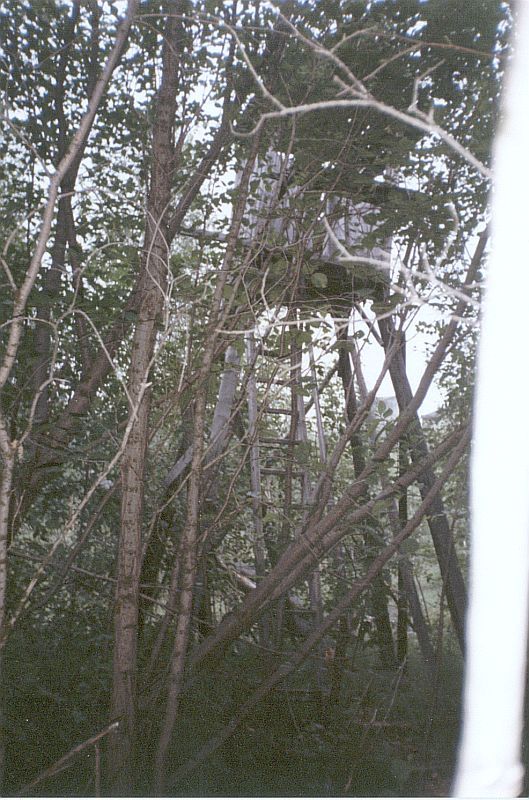
Look carefully on the right you will se one of the type of guard towers used at the Gulag
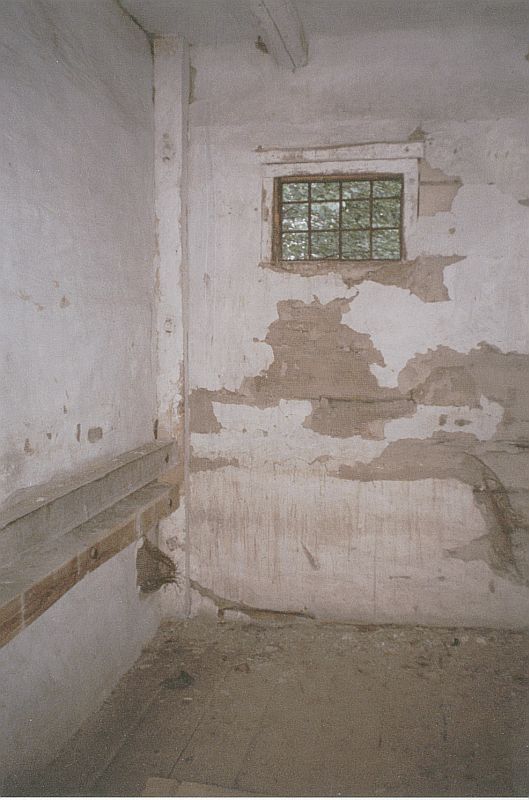
One of the cells inside the special prison building
As I was taking pictures from inside, several Polish visitors were outside lighting
candles, placing yellow ribbons on the window bars, kneeling and praying. When
I first arrived, I looked at the gulag with impersonal feelings. But, as I saw
this small ceremony, a chill went up my spine . My eyes started to swell with
tears, and I realized that here many innocent victims of Stalin's brand of communism
were people just like us. It had taken us 2 hours to walk to the gulag.
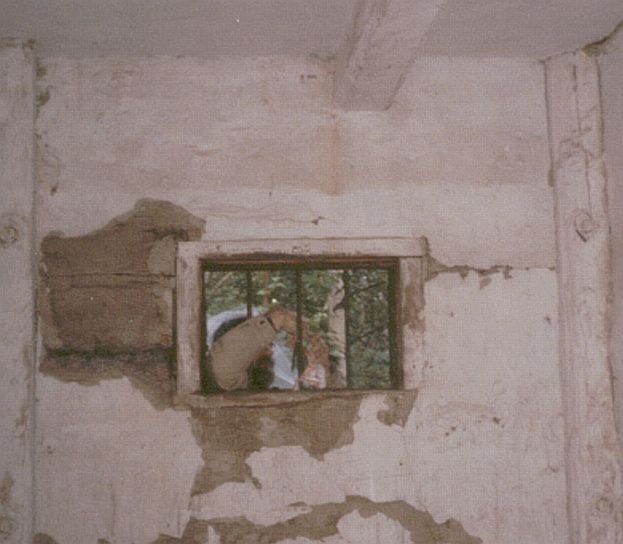
Here you can see someone tying a yellow ribbon to one of the cell's bars
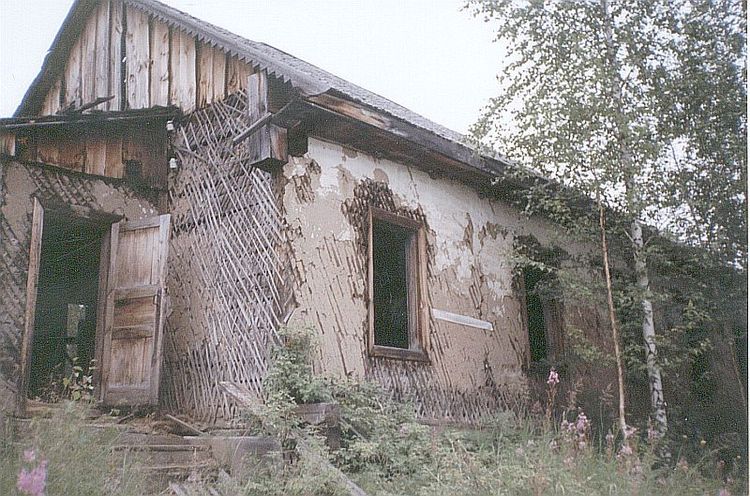
A final look at another of the remaining prisoner barracks
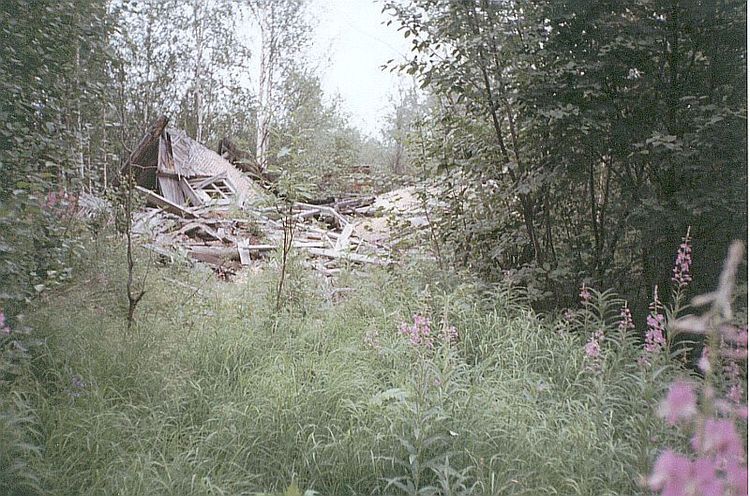
The weather did takes its toll on some of the barracks
Danuta and I spend about 15 minutes walking around. At no time did we stop to
rest. We started earlier than the others to walk back the way we came. Every
so often, we were passed by some of the faster walkers. The return to the location
of the atomic blasts was very slow, due to the many puddles and overflowing
streams. We kept on walking, slower it seemed.
Both of us were feeling pain in our legs. Danuta especially was feeling the
pain in her feet.
After we came to the steam engine we could walk a little bit better on flatter
trails. The lower part of my legs really hurt whenever I went down hill. And,
there were two very long downhill stretches that I really felt like stopping.
We finally arrived at the beach and moved slowly to the ship. We had walked
nonstop for 5 hours 20 minutes. The distance was about 16 kilometers. We were
the first to leave the gulag area, but almost the last to return to the ship.
1530: The ship pulled away from shore to continue upstream
travel. For the first time, the captain's scheduled departure was delayed. We
were to leave at 1500. Danuta and I returned with just 10 minutes to spare.
As it turned out, there were 3 persons still on the way back, including one
of the tour guides. The captain certainly could not leave anyone here.

1700: We recrossed the Arctic Circle. This time there was
no fanfare. The ship's captain did head the ship toward the opposite shore.
There we could get a better view and photos of a large sign on shore that
noted the location of the Circle.
1900-2000: The anchor was dropped midstream at the village
of Kurejka. Those passengers who went ashore on the lifeboat shuttles saw a
home in which Stalin had lived in his earlier years. Actually, he was banished
to this spot by the Czar for his political activities. The home was completely
enclosed in a concrete glass fronted building.
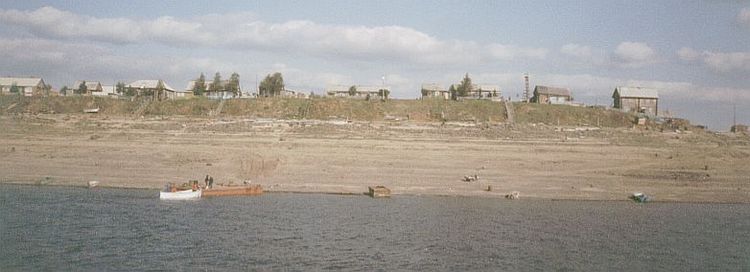
Kurejka from the ship. Note the small boats that took passengers ashore
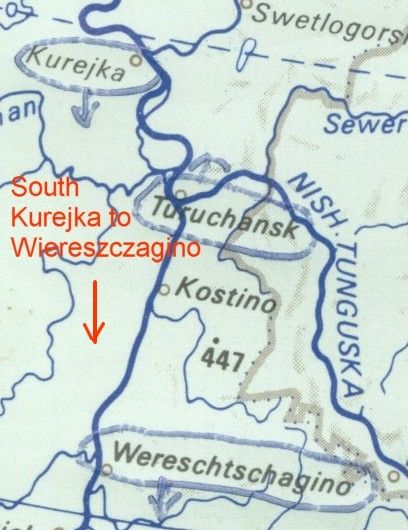
Tuesday, 3 August-1110-1800: At Wiereszczagino the ship again
had to anchor offshore. We were transported to landing docks by the lifeboats.
This was one of the cleanest villages we saw. It was muddy from the recent rains.
There were wooden sidewalks on each street which we used. Most of the ground
area was covered with grasses or other shrubbery.
There were many houses being constructed from log timbers. We had the chance
to go into them and see how they looked. The logs were cut and stacked for the
outer walls. Then the flooring was laid. Next, wall board or mud mixed with
straw was used to fill the cracks or cover the inner walls.
As we noted before, every home had a TV antennae on it. They all pointed toward
the center of the village. At that location we saw a large satellite dish, postoffice
and transmitter tower for the TV. Nearby were the instruments taking readings
on the weather.
While we were walking in the village, a Russian Army helicopter came in and
landed near us. The wind from the rotors made the trees and shrubs bend.
The stop at this village for seven hours seemed excessive. This was one of the
"Green Stops." There were walking trails behind the village that extend for
many miles into the forests. Some passengers go for a nature walk to see the
variations of plants and perhaps be lucky enough to see some new exotic bird.
Danuta bought a smoked fish for 200 Rubles. It looked thin, but she ate most
of it all alone. Can't believe we drank so much (we did share it). We bought
our 3rd bottle of cognac for 3100 Rubles.
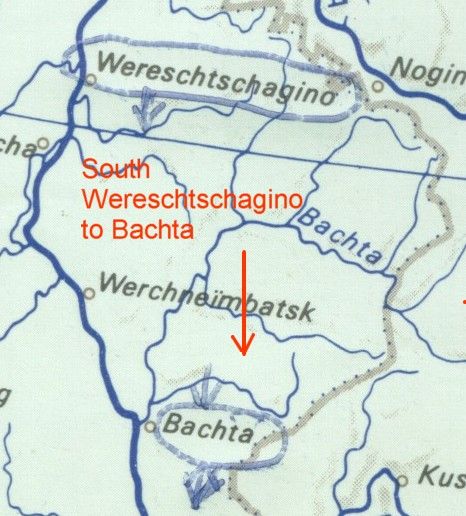
Wednesday, 4 August-0730-1200: The ship docked at Bachty. This
was another "Green Stop." Danuta and I just walked around the small village.
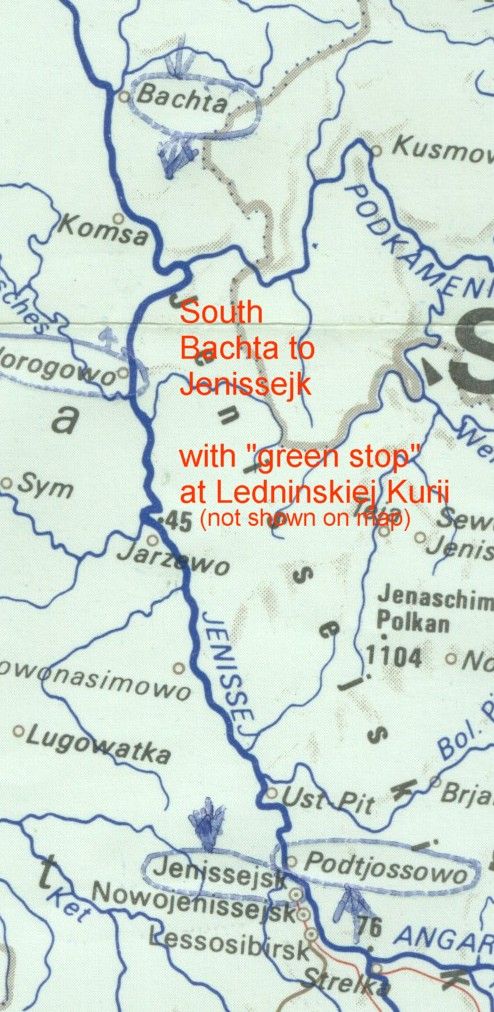
Thursday, 5 August-0620-1400: A "Green Stop" at Ledninskiej
Kurii. Unlike most of the other green stops, there was nothing here. The ship
however was able to move on its port side right up next to the beach. All that
was needed as a gangplank was the one section normally used when at a dock.
Both anchors were dropped about 50 yards from shore. Then when we left the winches
pulled the chain aboard and the ship moved in the direction of the anchors.
Just after 0800, some crew members began collecting firewood. We had a big bonfire.
After the fire was going strong, the crew put a huge kettle of water held up
by stakes, to boil. As it was heating, they pulled "weeds" which they called
herbs from the surrounding area. They broke off the flower portions and dropped
them into the pot. After a while, the pot was removed and all the bonfire guests
were invited to help themselves to the herbal tea. I only took one sip. It wasn't
really bad.
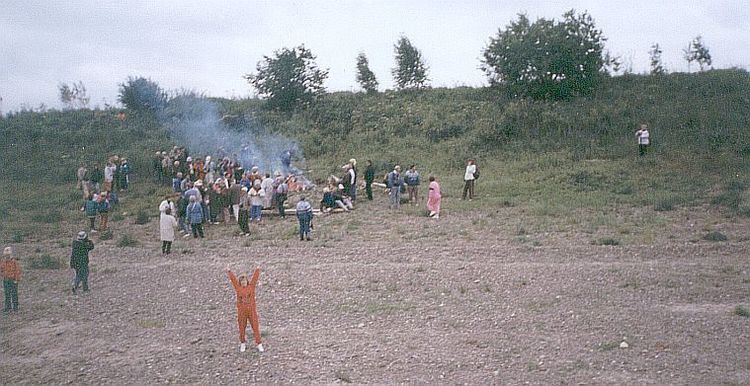
We stop for the big bonfire and special herbal tea prepared by the ship's chefs
On top of the flat plateau above the bonfire, was a large well farmed and plowed
area. Those who wished could walk through the distant trees.
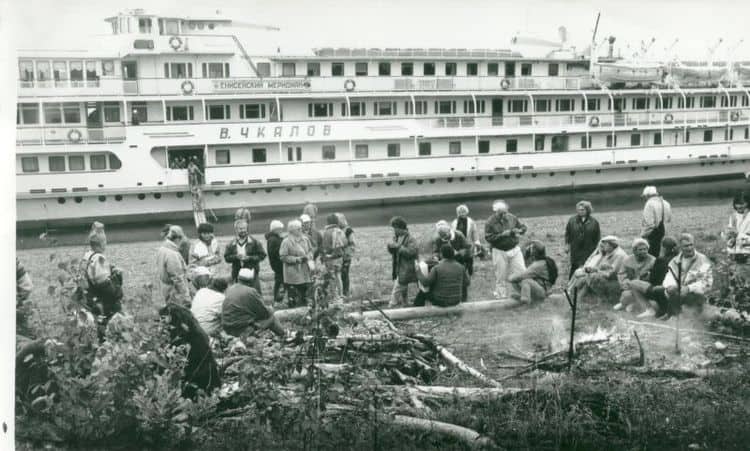
Looking down on the bonfire and the ship from the plateau
2100: While underway, a "Mr. Cruise" contest was conducted
on the upper open deck. There were five male contestants. They really made the
audience laugh at their antics. It was conducted in both Russian and Polish
languages. So, while I did not really understand what was being said, the antics
were enough to make me laugh as well. The man I thought would win came in third.
I bought Russian beer on the ship for 250 Rubles. Danuta had a chocolate bar
costing 650 Rubles. It was so good, we bought another.
Friday, 6 August-0720-1430: We arrived and docked at the larger
city of Jenisieska. (English for the same as the River, Yenisey.) Danuta and
I walked for several kilometers in all 3 directions of this city.
We were able to enter a 19th Century Russian Orthodox Church that was being
renovated. This one, like most others we saw on the river, had been converted
to warehouses, theaters, or just boarded up since the early 1920's. Now, with
the demise of communism, the churches were returned for religious purposes again.
However, years of neglect and decay have required much renovation.
After we left, a working monk came from his home and locked the gate behind
us. As we left, other passengers from the ship were turned away without getting
entry.
This city had the usual mix of really old log cabin structures mixed with modern
log cabins and concrete buildings. All of the other villages and towns had sloping
shorelines of rock and sand, where the water level rises to the top in the Spring.
Here, the city had constructed a concrete barrier wall with a road entry sloping
down to the water at low level. During the spring high water flow, the wall
would become the edge of the river.
We went on a spending spree in this city. There were many shops. We bought an
eyewash glass for 1 Ruble, two cans of lunch meat (to eat on return to Gdansk)
for 3000 R. Danuta bought a wooden egg for 200 R, and several hair combs and
brushes for 41 R. Other items included two beers for 1200 R, a whole salmon
fish for 420 R, champagne for 2030 R, wall screws with drill for 368 R, and
a stereo ear phone set for 211 R. At a book shop I found four map books on Russian
history for 8 R, and two photos of historical interest for 800 R. After returning
to the ship, Danuta looked at the egg and hair combs. She liked them so much
she ran back to the store to buy even more. We really splurged here and spent
a total of 9,899 Rubles. That was about $9.90.
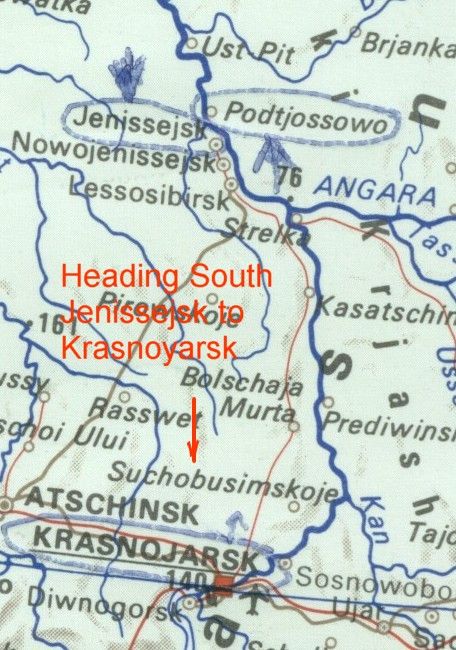
2000: After dinner, Danuta and I went to the deserted music
room just ahead of our cabin. We wanted to watch the beautiful scenery again.
We had bought the champagne to take later to the nightclub, to share a farewell
drink with our friends. Instead, we drank the whole bottle in the two hours
we sat watching the sights go by. We again saw much of the cliffs and islands
around an area where the river makes an 180 degree curve. We reminisced about
our trip. We discussed what we might have ahead of us on the return trip to
Gdansk. In reality, it was just a wonderful time being together as we viewed
the great outdoors.
Saturday, 7 August-0100-0520: The ship stopped along a stretch
of beach, anchored and stayed there until 0520. This was on the opposite end
of the "gap" in the river, where we anchored overnight on the 26-27 July. As
we noted then, the ship could only go through that "gap" during daylight hours.
When we did get underway at 0530, there was low fog on the river.
0520-2310: We continued upstream (South) without stopping until
we reached Krasnoyarsk. As the morning fog left us, the day became warm and
beautiful. I was able to time the distance between mileage markers, again. I
computed our land speed at 15 kilometers per hour. This considered the river
flowing against us plus the speed of the ship.
At an area called Mt. Barina on the eastern side of the river, we came across
the super secret atomic plant. We could see the high double fences that ran
up the side of the hill at the start of the compound. There were guard towers
ever few hundred meters. The area between the double fences was well cleared
of shrubbery. There was another shorter fence running up the middle of the cleared
space, with a paved road next to it. As the fences paralleled the river, we
could see the end of the electrified railroad tracks and tunnels.
Every so often, where the mountain came close to the river, there was what appeared
to be a tunnel entrance to the mountain. Each of these entrances was of concrete
construction. I noted the mile markers at the start about 83 Kilometers and
the end about 78 Kilometers (from the docks at Krasnoyarsk). At the northern
end (start) was a huge living community, well lit, looking much like a prison
compound. Beyond that were two huge smokestacks.
As we continued south, there were frequent signs of active military and other
heavy equipment construction sites. The Krasnoyarsk dam provided all of the
power for this area. We visited the dam later.
2310: We arrived at the dock at Krasnojarska (Krasnoyarsk).
2300-Sunday, 8 August-0200: We decided to go dancing in the
nightclub. We sat with a different group of people this time. I danced up a
storm, as usual. Again, it seems as though I did all the buying. I paid for
two bottles of really good white wine, 4600 Rubles.
 Return now to Introduction |
 Return to Part 3 |
 Continue on to Part 5 |
